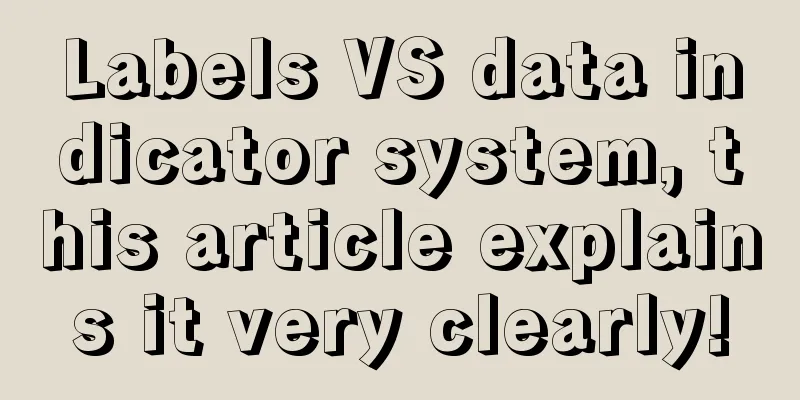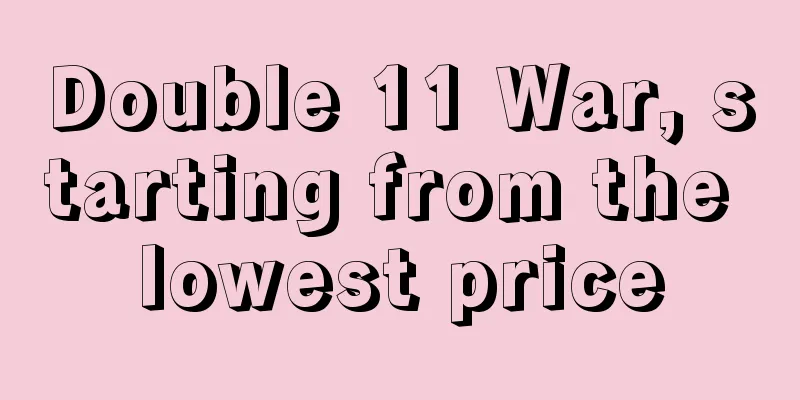Labels VS data indicator system, this article explains it very clearly!

Data indicators, indicator systems, dimensions, and labels are all basic concepts in data analysis, but students often confuse them. Understanding the differences between these concepts will not only make reports clearer, but also make it easier to find ideas when analyzing problems. Today, I will systematically explain the differences between these concepts. 01 Data indicators VS indicator systemFor example: There is a boy who is 150cm tall, a boy, and very strong. Here, 150cm is a data indicator. Data indicators usually use numerical values to measure an objective fact. However, it is difficult to explain things clearly with only one indicator. You may doubt "Why is the boy 1.5 meters tall?", so we need a series of indicators, such as age 12 and height 150cm. When there are more indicators to describe things, an indicator system is formed. In enterprises, there are three common indicator systems: The first type: parallel type. It is often used to evaluate the performance of an individual from multiple perspectives, such as evaluating employee performance, evaluating supplier performance, evaluating new products, etc. It is called parallel type because the indicators involved in the evaluation are independent and exist in parallel (as shown in the figure below). The second type: total-to-score type. It is often used to describe a whole consisting of several parts. The most classic one is profit decomposition, which divides the profit into several parts according to the source of income/cost, making it easier to analyze the reasons for profit changes (as shown in the figure below). When observing the total score indicator system:
This makes it easier to see the problem. This principle also applies when comparing multiple individuals. The third type: process type. It is often used to describe a process from the beginning to the end. In sales, it is often called the funnel model. Because in the sales process, every additional step will lose some customers, just like a funnel. Most sales processes are funnel-like (as shown below): When observing the funnel indicator system:
This way you can understand the whole process. Some students get stuck in the details right from the start and end up getting confused. Of course, there are more than just funnels in the process. For example, in production, service, after-sales and other links, there is also a complete process, but it is not a gradual decrease. For example, the production task must be completed, but as the production process increases, each step will increase new raw materials, production costs, and labor costs. At this time, the cost and time consumed by the entire process are increasing step by step. With a data indicator system, you can understand the business situation in detail, but if you want to promote business behavior, you still need the support of labels. 02 Data indicators vs labelsFor example, there is a boy who is 150cm tall and looks very strong. Here, "boy" is a classification dimension. The classification dimension is not a continuous value, but a qualitative description used to distinguish individuals. "Strong" is a label. Note that handsome is also a classification dimension, but its business meaning is clearer and makes it easier for people to think of what business actions to take. For example, if a boy is labeled "strong", then the next time the class is looking for labor for the general cleaning, the goal will be much clearer: "Gather all the strong boys in our class!" The business meaning is clear and it promotes business actions, which is the role of labels. Some labels can be calculated from data indicators. For example, a child scored 98 out of 100 in math. We can make a rule: those who scored 95 or above are considered "good at math." So the child with a score of 98 is labeled "good at math." Next time there is a math competition, we can say, "Select the children who are good at math to participate," and we can directly pull this child to participate in the competition. When we need to purchase materials for a class meeting, we can say, "Select the children who are good at math to do the accounting," and we can directly pull this child to go. It can be seen that good labels can improve the efficiency of business operations. Here comes a question that often bothers new data scientists: How do we define 95 points as "good at math"? Why can't it be 98 points? When calculating labels through indicators, there are generally two ways. The first is the business convention. For example, everyone is used to thinking that 95 points in math is already very high, so that's it. After all, labels are for business use, and what they think is most important is that they are easy to use. The second method is to perform data testing based on the purpose of labeling. For example, if we select students who are good at math in order to participate in math competitions, then the scores of students who are labeled as "good at math" should be significantly different from those of ordinary students. Therefore, we can design an experiment to see the differences in the results of students with different scores in the competition, so as to find a reasonable segmentation standard (as shown in the figure below). 03 Label + indicator system = high-quality data analysisWhen doing analysis, students often stare at an indicator in a daze: Why did it go up or down? What does it mean? At this time, you can try: 1. Build an indicator system and observe data details 2. Add labels, quantify influencing factors, and analyze the source of the problem. With more comparable labels and analyzable indicators, it is easier to draw conclusions. Through tags + indicators, you can look at the problem in depth. For example, when analyzing the promotion effect, 1. Look at the indicators first: Which channels have high conversion rates? Which ones don’t? 2. Look at the labels again: For channels with high conversion rates, what is the level of materials/products/discounts used? With this vertical and horizontal pattern, it is easy to see where the problem lies (as shown below). Through labels + indicators, we can find inappropriate comparisons and avoid misjudgment. For example, if we see that there is a difference in performance between two teams, we cannot simply say: whoever has higher performance is the benchmark and we should learn from him. 1. Are there differences in the personnel structures of the two teams? 2. Are there differences in customer resources between the two teams? 3. Are there differences in the sales methods of the two teams? At this time, you need to label personnel quality/customer resources/sales methods, and then observe the differences in corresponding indicators to draw more accurate conclusions (as shown in the figure below). In short, you need to be proficient in operating labels and indicator systems to make high-quality analysis. |
<<: Let’s have some dried dry goods: 3 ways to find potential incremental categories
Recommend
How does Shopee’s cross-border e-commerce attract traffic? What are the techniques?
Cross-border e-commerce has become popular recentl...
With 50 million members and member contributions accounting for over 50%, how does Dicos operate its private domain?
"Private domain" is a hot operation conc...
8 million sold in one day, "outdated items" are selling well in the off-season
Behind the off-season sales is the clothing indust...
What are the Russian e-commerce platforms that individuals can enter? What are some suggestions for entering Ozon?
Nowadays, more and more people are engaged in cros...
Luckin Coffee and Kudi, hovering around 9.9
This article analyzes the low-price strategy of th...
Does Amazon need to declare customs when sending FedEx? How long does it take?
If you purchase goods on Amazon's cross-border...
How to ship Gmarket from South Korea to China? Where to transfer logistics from South Korea to China?
More and more people are choosing to look for more...
The tried and tested method of Xiaohongshu's popular articles
Any popular article on Xiaohongshu is not accident...
Don’t let the membership of Taobao, Pinduoduo, JD.com and other e-commerce platforms change
Judging from the data, all major e-commerce platfo...
300,000 people crowded into Zhang Lan’s live broadcast room, just to “eat melons” without paying any money?
300,000 people crowded into Zhang Lan's live b...
How is Amazon Belgium? How to join?
Today, I will introduce you to the content of Amaz...
What activities are available on Shopee now? How to sign up?
There are a lot of activities on e-commerce platfo...
Does Wish need to pay a deposit? What are the requirements?
Everyone has heard of the Wish platform. Since e-c...
Duan Yongping and Jiang Xiaobai: Who understands marketing better?
There are a lot of invisible marketing now, and ma...
Mental strength, mind, and heart capacity, 24 business rules
This article explores the four key dimensions of b...









